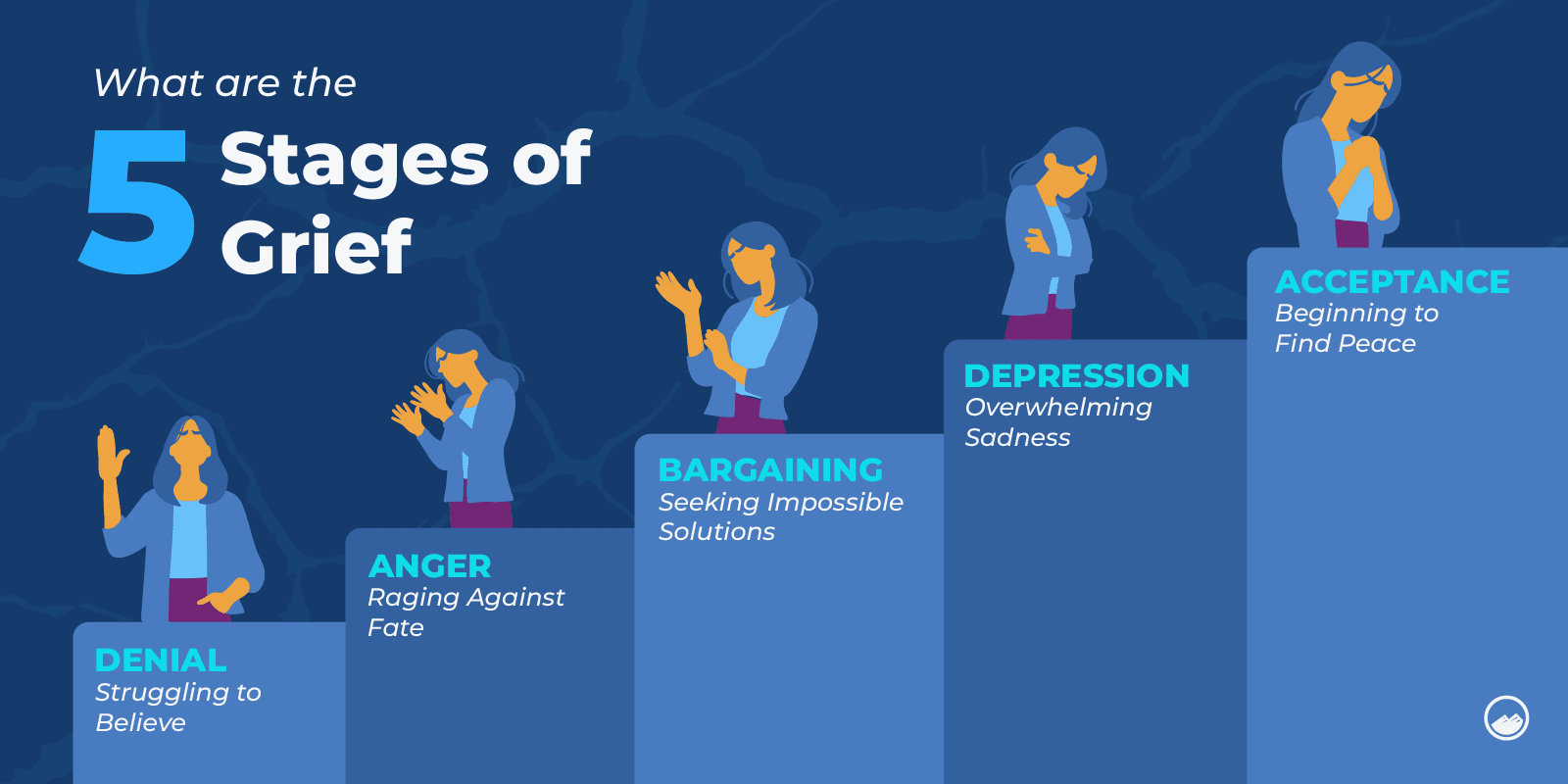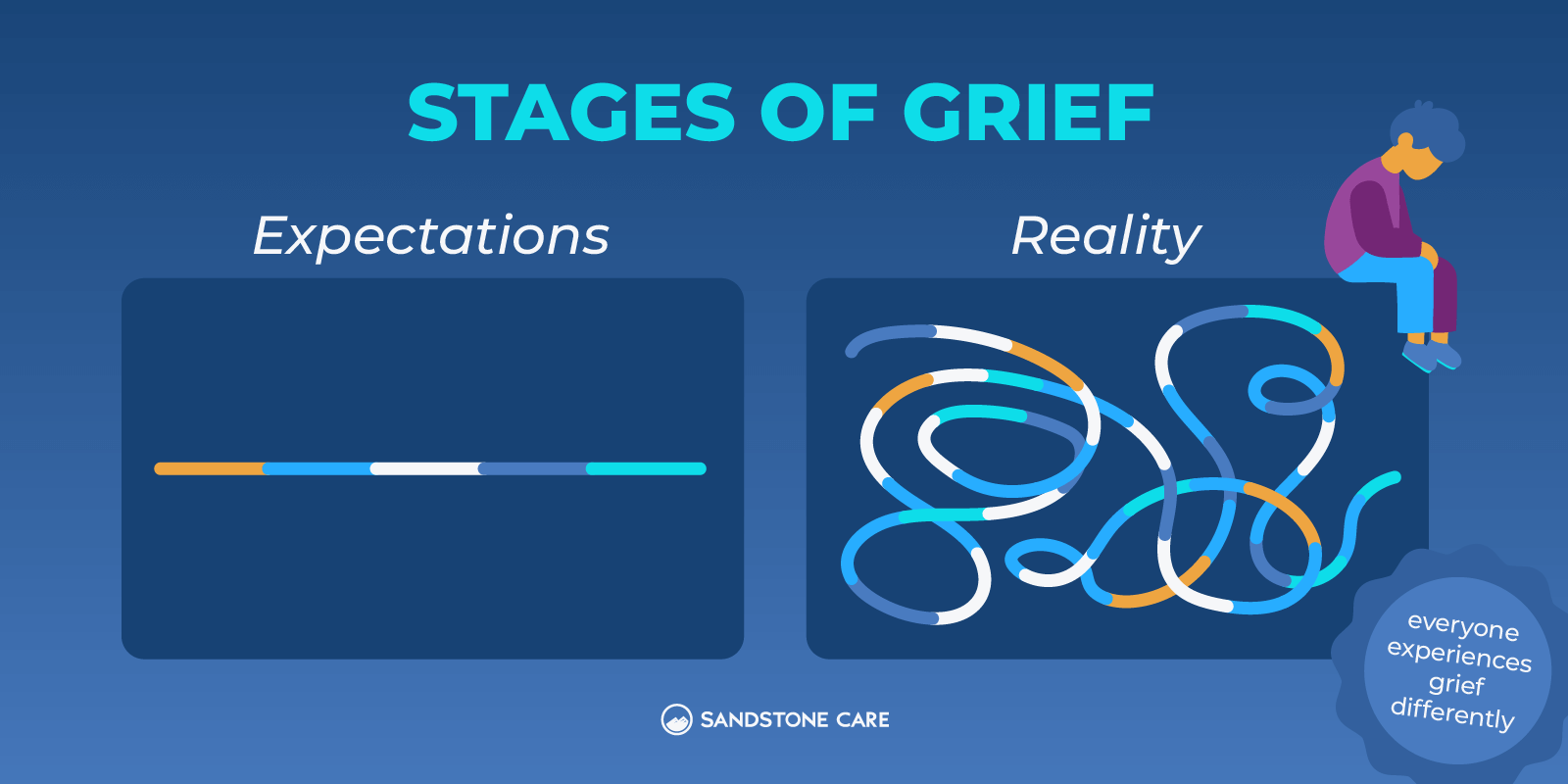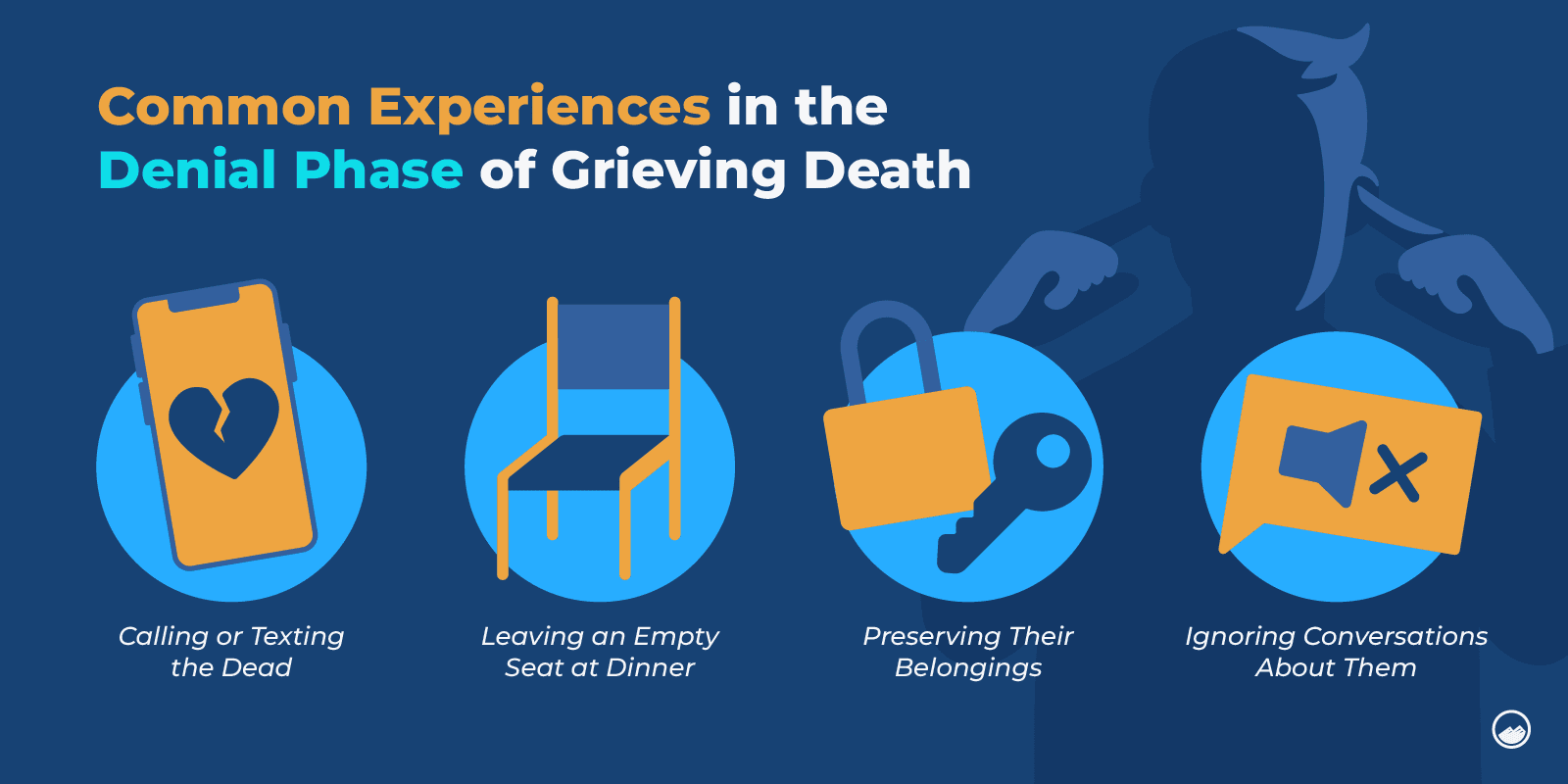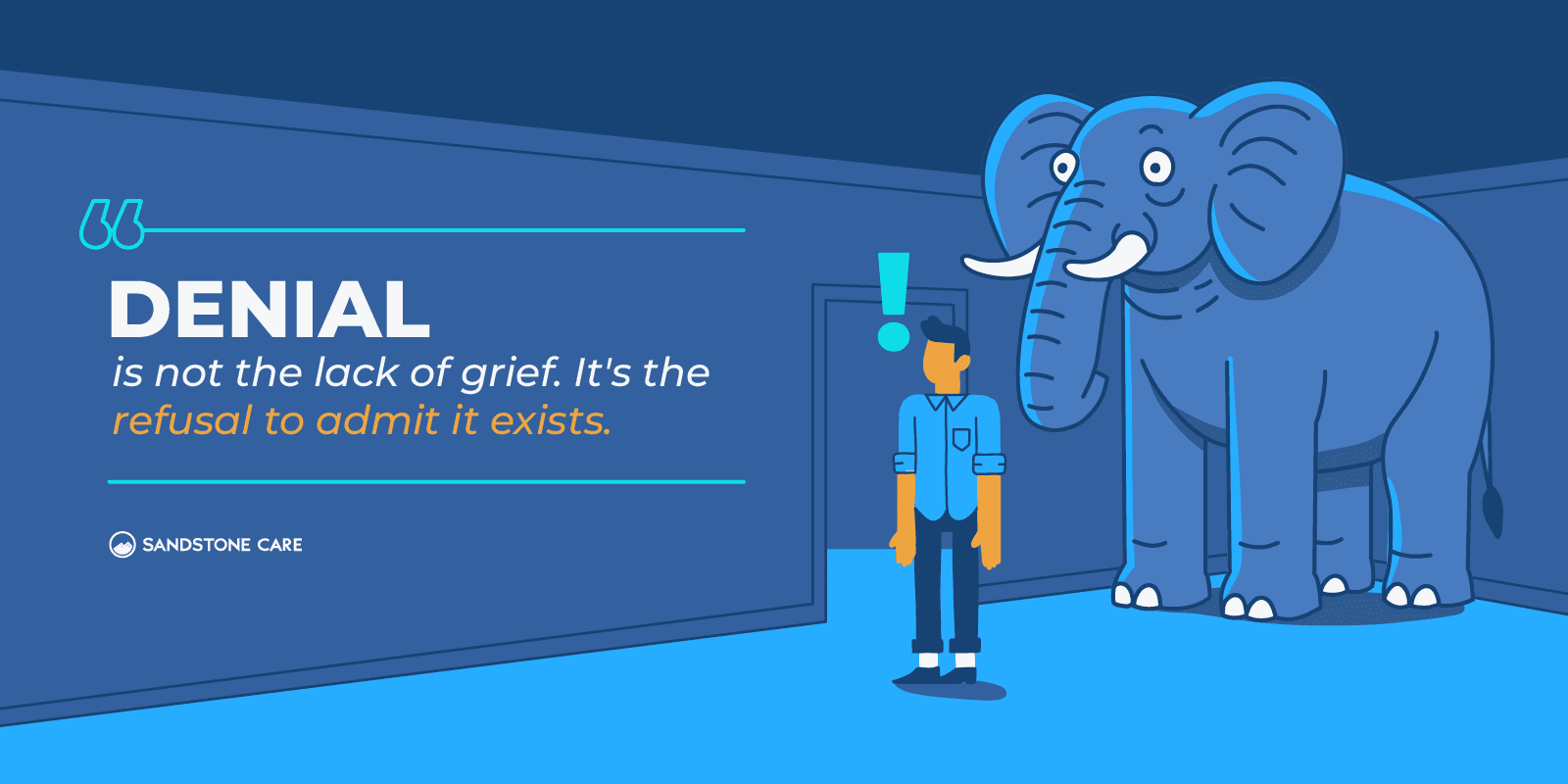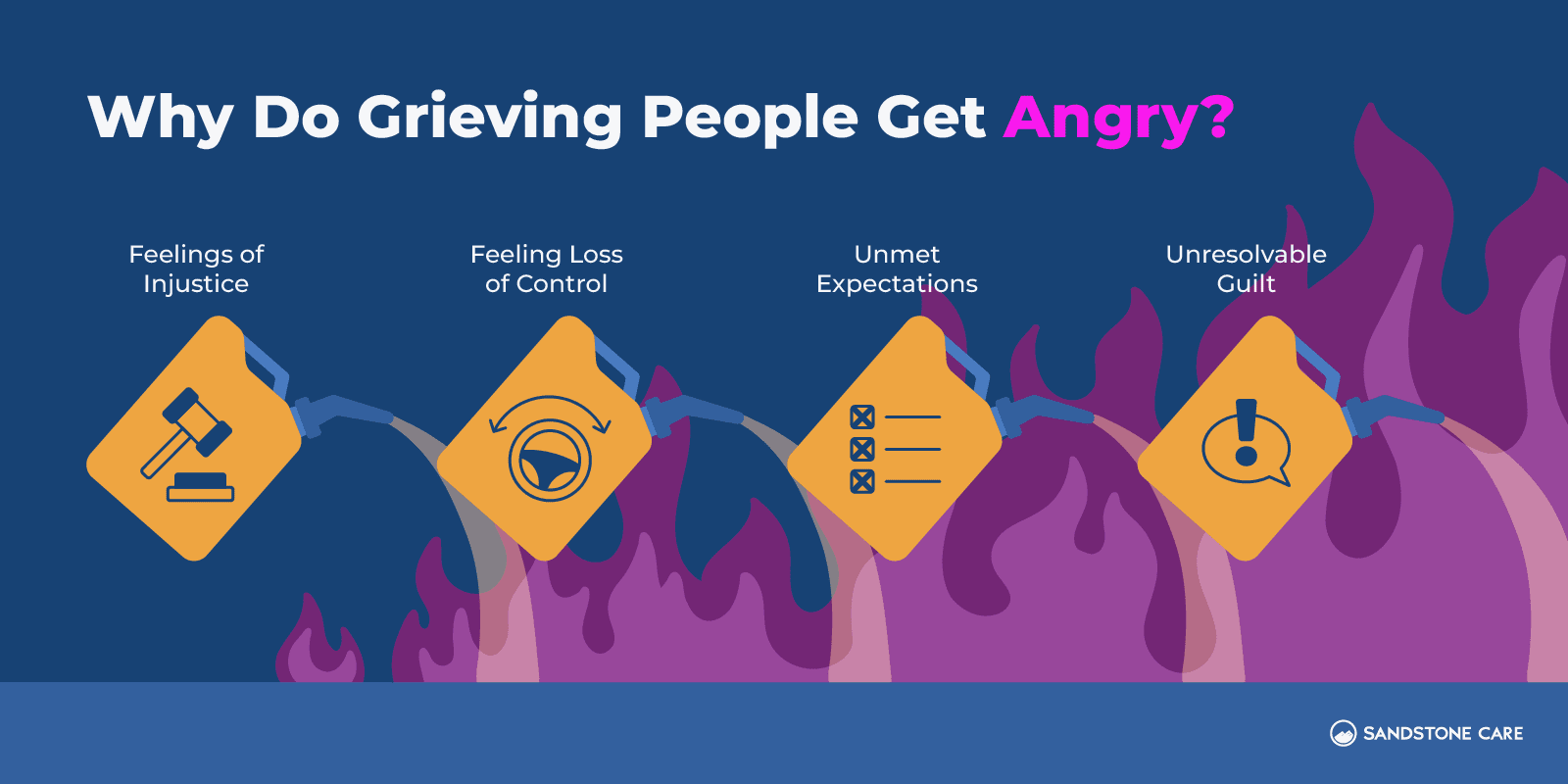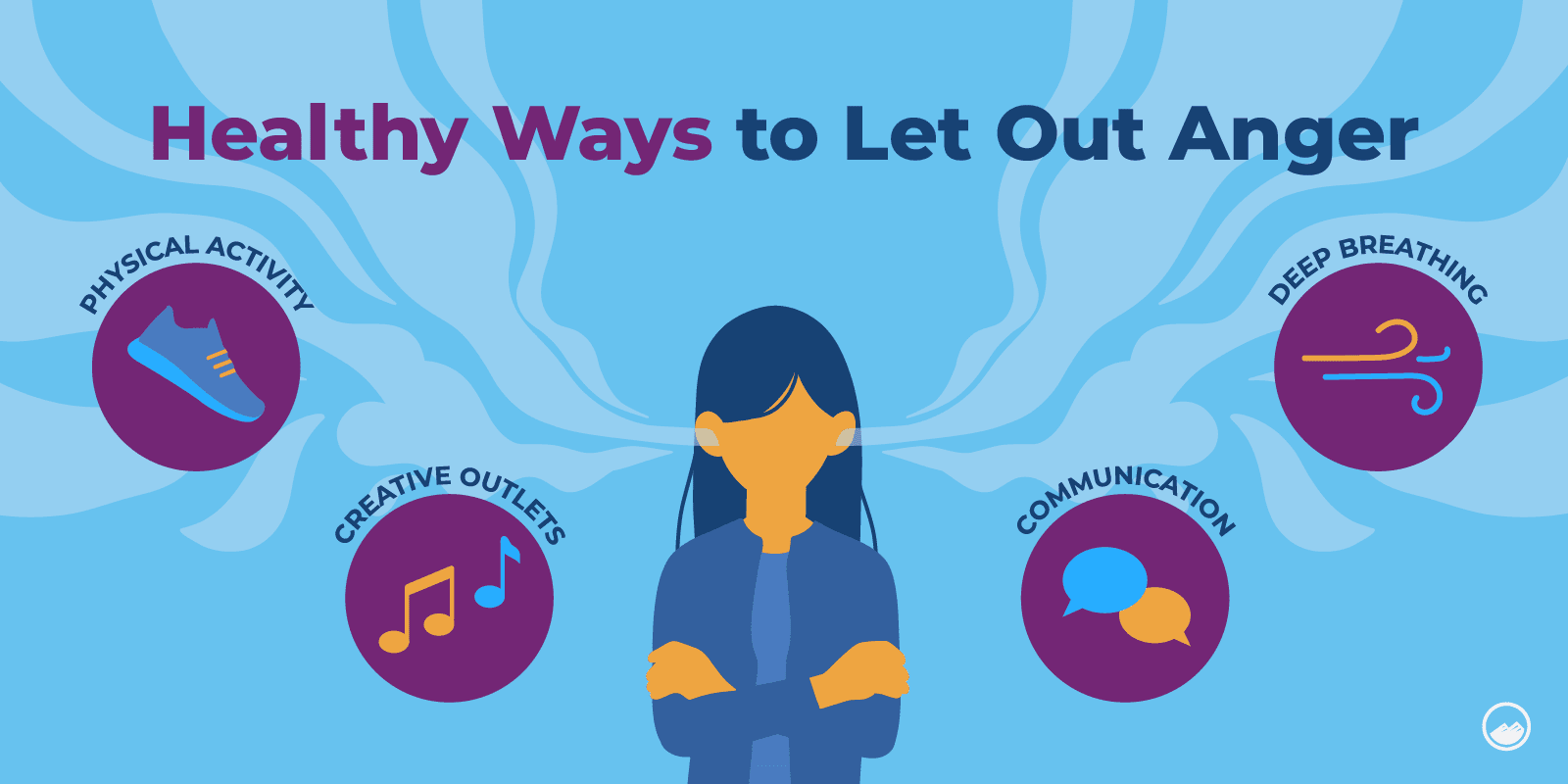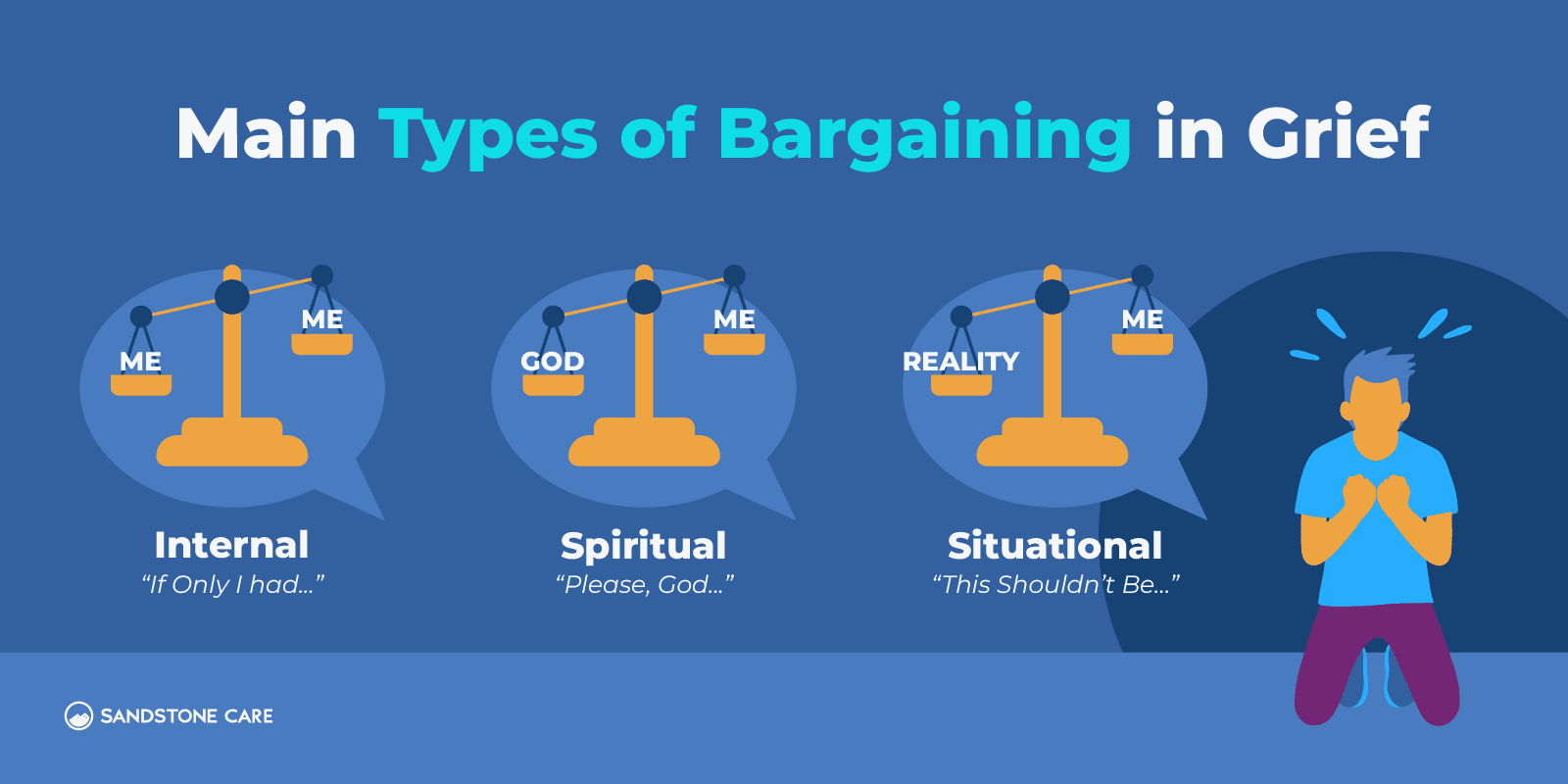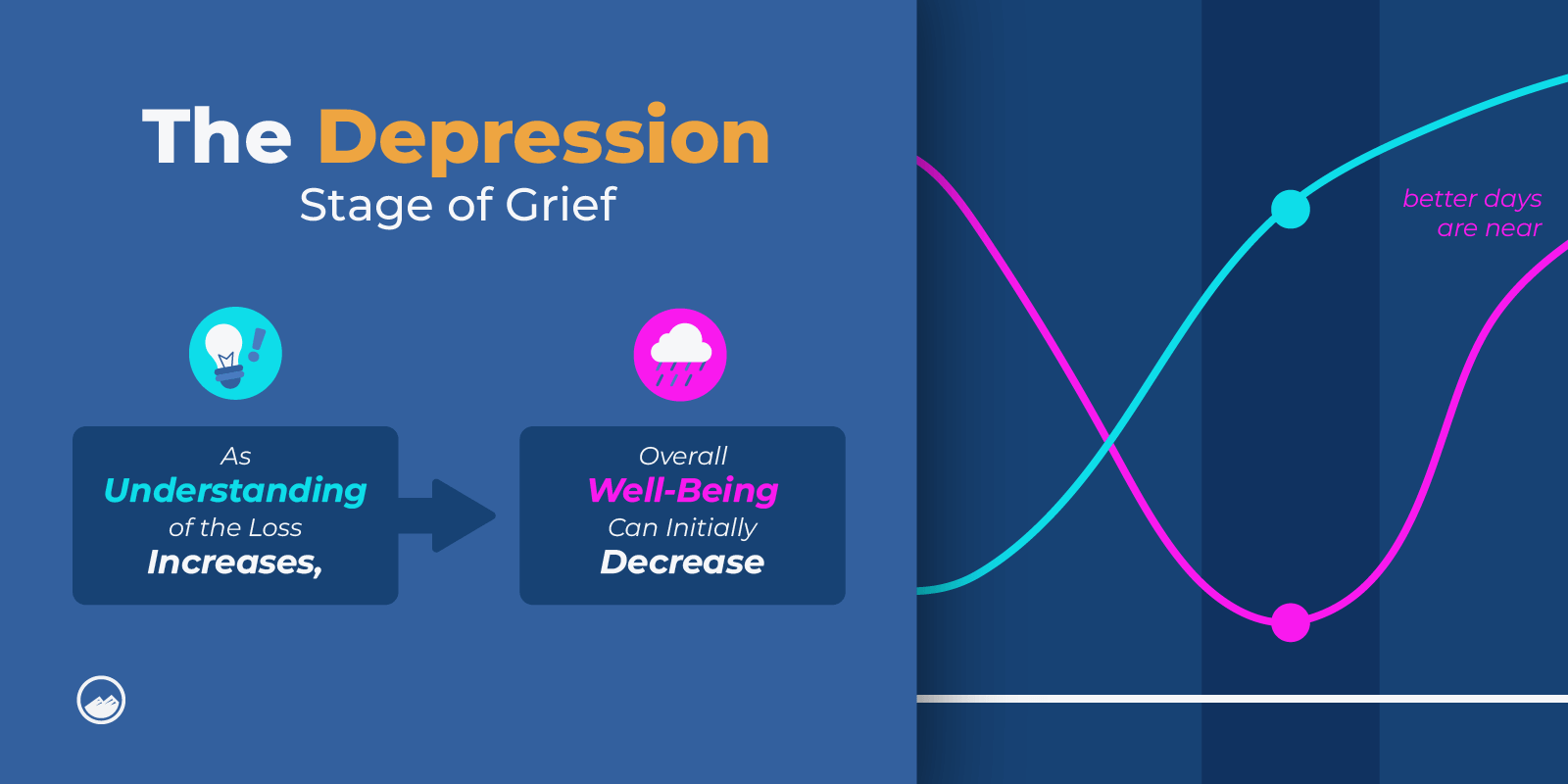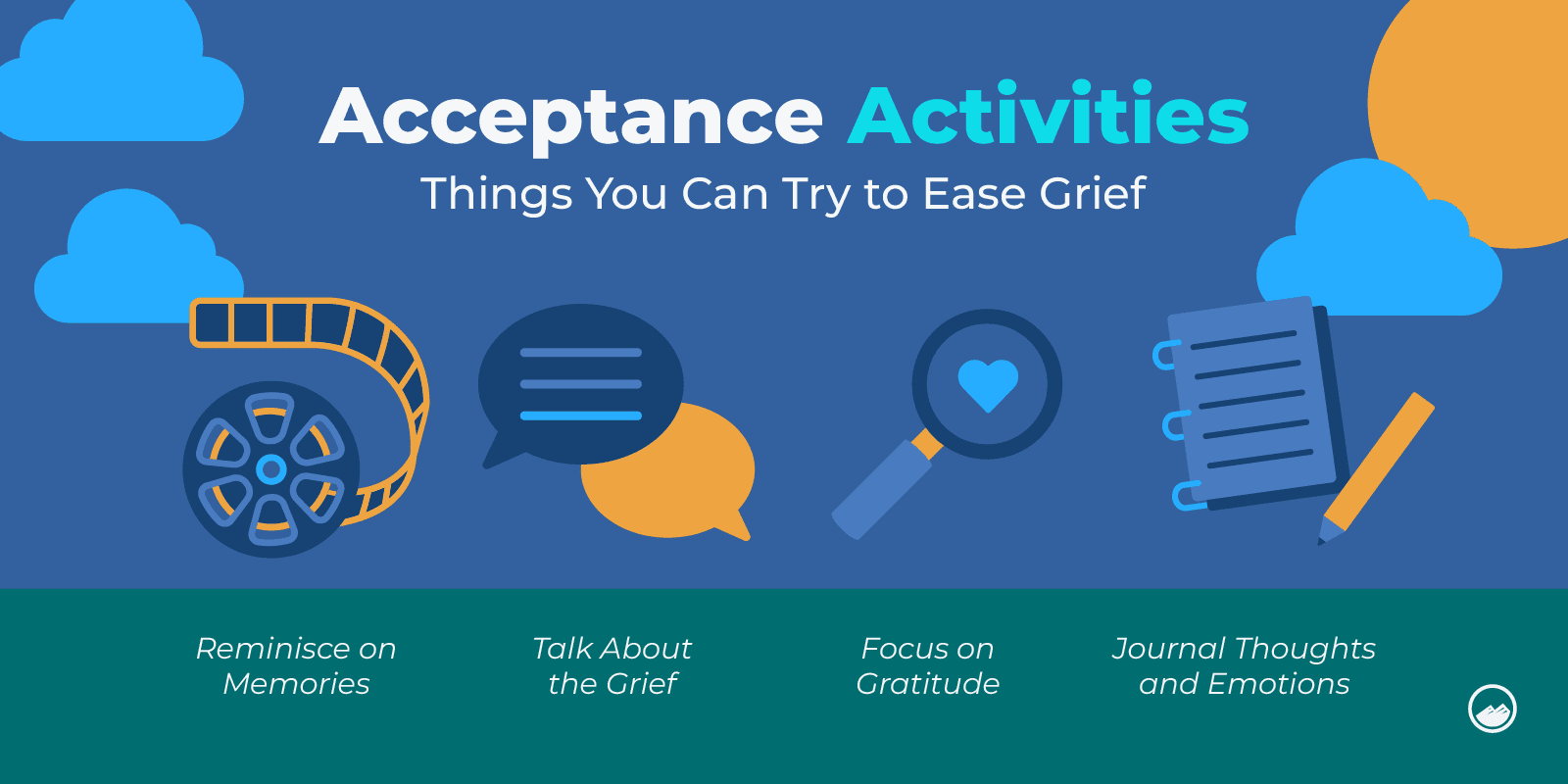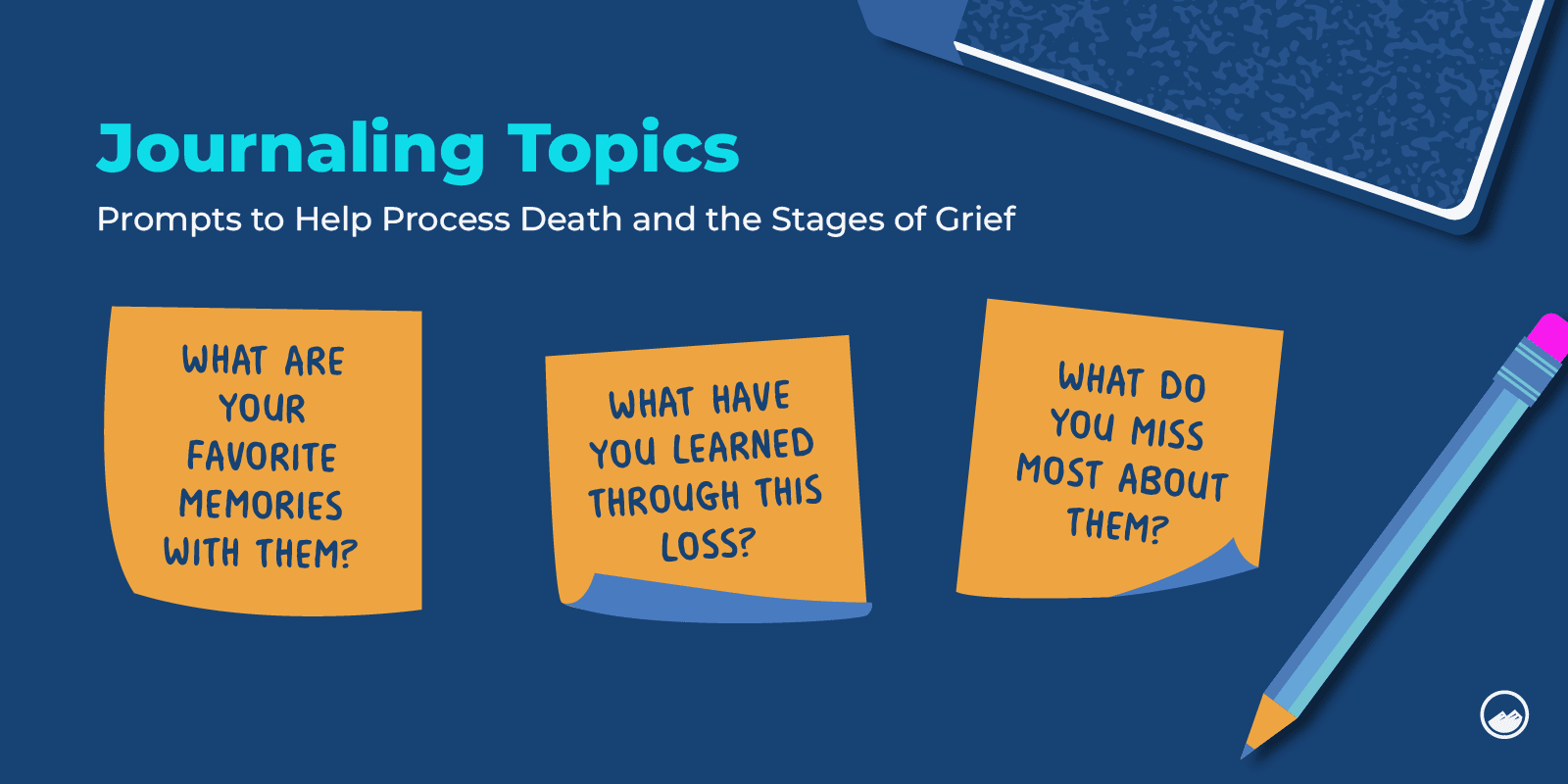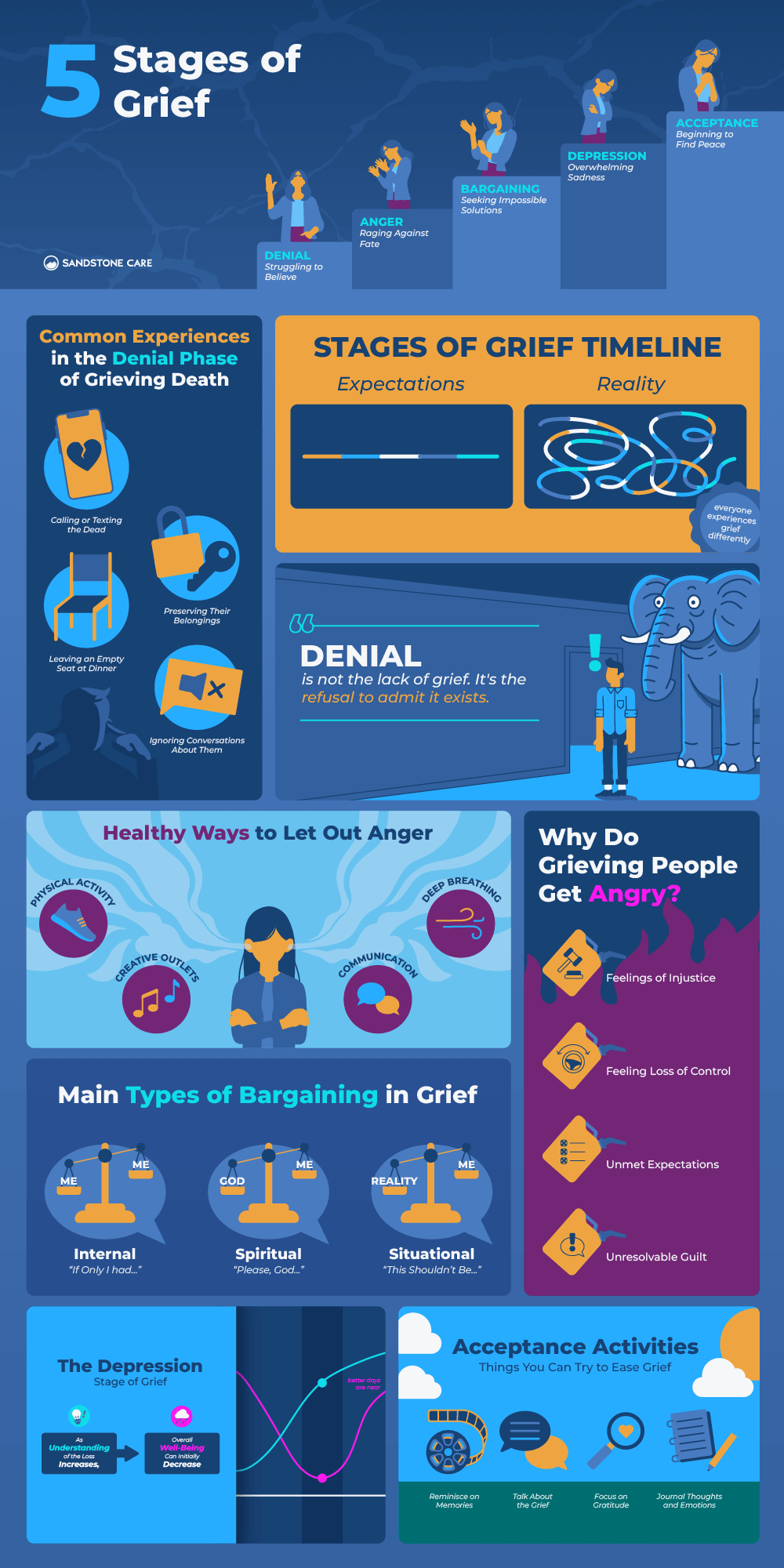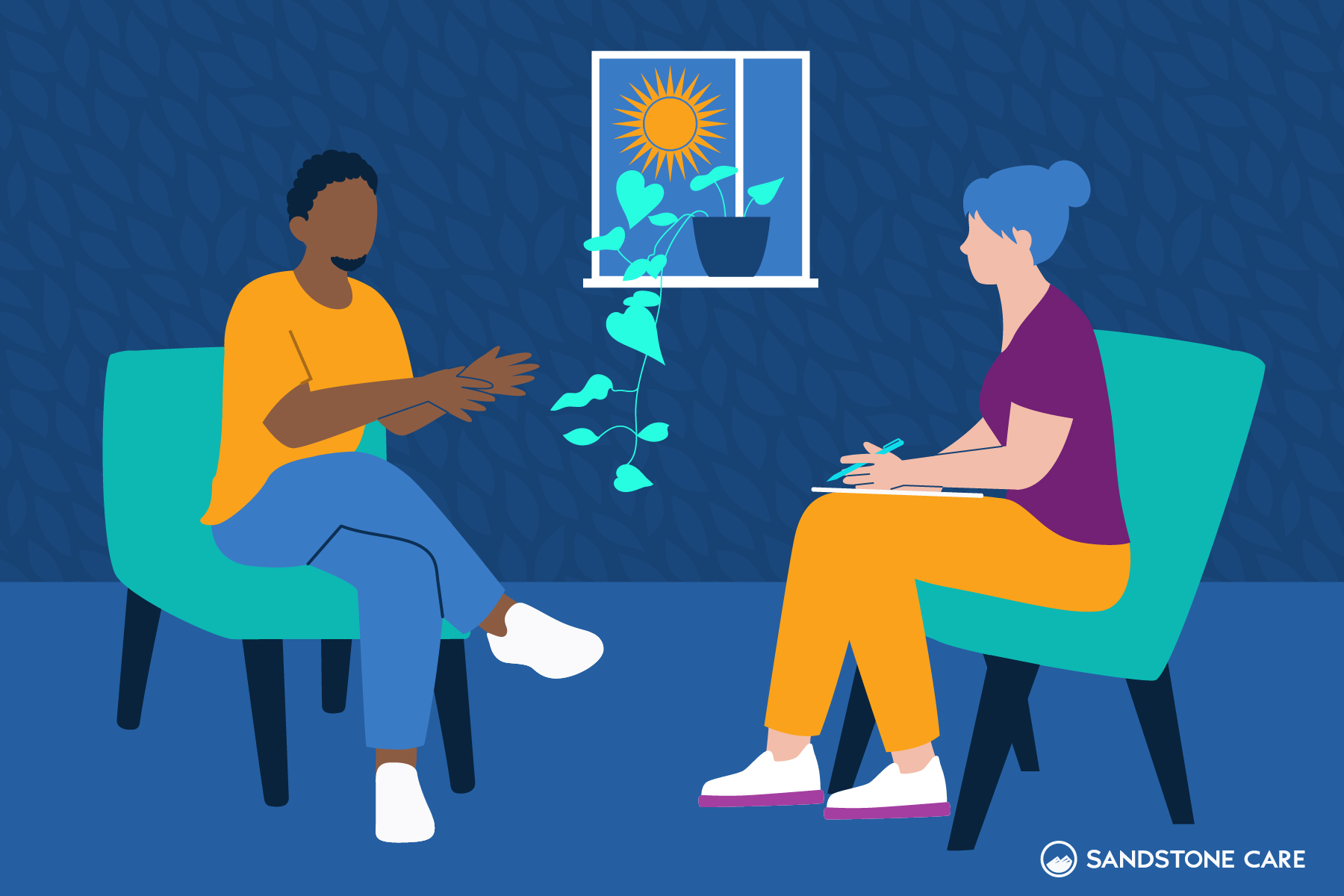5 Stages of Grief in Order
What Are the Five Stages of Grief in Order?
The 5 stages of grief include:
- Denial
- Anger
- Bargaining
- Depression
- Acceptance
The stages of grief are often used to help people understand and navigate the complexities of grief.
However, it is essential to remember that grief is not always straightforward, and it does not always follow a specific order or timeline.
Different types of grief can occur from different experiences, such as:
- The death of a loved one
- End of a relationship
- Loss of a job
- Diagnosis of a terminal illness
- Moving to a new place
- Substance use and addiction
Do the 5 Stages of Grief Happen in Order?
The 5 stages of grief don’t always happen in order.
Many people often experience all of the stages at some point during their grieving process, but a mix of difficult feelings can come at any time.
Some might go back and forth between stages. Others might skip a stage as they develop different defense mechanisms.
The most important thing to know is that all people experience different types of grief, and those experiences will often be handled in different ways.
How Do I Know What Stage of Grief I Am In?
You can uncover what stage of grief you are in by looking out for common signs and experiences that are associated with the stages of grief.
Common feelings of grief can include:
- Denial
Feeling shocked or having difficulty believing something has happened. Rejecting your new reality in favor of trying to keep everything feeling as normal as possible. - Anger
You might feel angry at yourself, your loved ones, God, or the world. - Bargaining
At this stage, you might try to make deals to undo or “fix” what happened. You also might find yourself fantasizing about going back in time. - Depression
Feeling helpless, numb, sad, empty. If you are going through this stage you might have no interest in anything, it can be difficult to do everyday things, and you may often feel exhausted or extremely drained. - Acceptance
At this point, you might come to terms with reality. Even though it might still be difficult, some weight might be lifted off of you as you navigate your feelings of grief while being honest about your circumstances.
If you are experiencing feelings similar to those in each stage, it might help you figure out what stage you might be in and better understand how to get help.
Why Are the 5 Stages of Grief Important?
The five stages of grief can help people understand their feelings better, acknowledge them, and recognize when to seek help.
For those who have been diagnosed with a terminal illness, going through the stages of grief in any order can be a helpful way to make peace with their own death.
Those who are bereaved persons from losing loved ones can also process their emotions effectively in the stages of grief, especially if they don’t turn to unhealthy coping mechanisms.
Are the Stages of Grief Real?
Criticism of the Kübler-Ross model has argued that the research and application of the five stages of grief have not been empirically validated.
However, the stages of grief can be used as a guide to understanding why a person feels the way they feel and help them address ways to get help.
While the stages of grief may not be a scientific metric used in psychiatry, it can still be valuable for people who are going through traumatic experiences.
Having the words to articulate a complex experience can help those who are grieving to feel confident in asking for support.
Denial Stage of Grief
What Is Denial in the Five Stages of Grief?
Denial in the 5 stages of grief is a natural response and can involve refusal to accept the loss or disbelief that the event happened.
When a person is faced with loss, hearing about it or first experiencing it can be extremely overwhelming and difficult to process.
The denial stage of grief can sometimes work as the brain’s defense mechanism.
Sometimes, the sudden experience of a loss is too much for a person to take in, so denial might help the process of understanding this information and give a person some time to take in their new reality.
It is important, however, that this is avoidance behavior should be a temporary stage.
What Does Grief Denial Look Like?
Grief denial can look different from person to person.
This stage serves as a defense mechanism to help cope with overwhelming emotions by allowing individuals to gradually process the reality of the loss.
By denying the reality of the loss, individuals can temporarily avoid the pain, fear, and sadness associated with it.
This protective barrier helps them continue functioning in daily life without being completely overwhelmed by grief.
Common signs and characteristics of grief denial can include:
- Emotional numbness
- Feelings of confusion
- Disbelief about the loss
- Sleeping more than usual
- Keeping themselves busier than usual to distract themselves
- Engaging in substance use to escape reality
- Shutting down
- Forgetting about the loss
Someone in the denial stage of grief might try to call or contact the person who they have lost or look forward to seeing them before realizing that they are not here anymore.
How Long Does the Denial Stage of Grief Last?
There is no set timeline for the denial stage of grief.
However, long-term denial may indicate that the person needs some extra support as they try to heal from their loss.
Professional support from therapists and psychiatrists can help assess how long a stage like denial is helpful for each person’s unique circumstances.
How to Get Out of the Denial Stage of Grief?
One way to get out of the denial stage of grief is by allowing time to go by and taking everything one day at a time.
Some days can be harder, but you can start healing over time. There is no timeline or rush to figure everything out or to “be okay.”
To cope with the feelings during the denial stage of grief, it can also be helpful to journal and write down what you might be going through.
This might help you process things and release your feelings on grief.
Lastly, talk to someone.
Whether it is a friend, loved one, or a professional, talking to someone can help you process a loss and let go of some of the weight you might be holding.
How to Help Someone in Denial Stage of Grief
One way to help someone in the denial stage of grief is to be there for them when they need it and be there to listen and offer support.
Try to stay calm and be gentle with your words.
Often, someone in this stage of grief just needs to let out their emotions, and they need someone to be there for them and make them feel safe enough to share how they are feeling.
If someone close to you is having a very difficult time in the denial stage of grief, you might think about helping them get professional help.
Encouraging them to talk to someone, such as a therapist or another mental health professional, going to grief counseling, or attending a support group can help them feel supported and get the help they need.
Anger Stage of Grief
What Stage of Grief Is Anger?
Anger is considered the second stage of grief, but a person can experience the different stages of grief in different orders.
After the denial stage of grief, when a person realizes the reality of the loss, it can bring up an overwhelming amount of different emotions, including anger.
What Is Anger in the Five Stages of Grief?
Grief can cause intense feelings, which can sometimes result in anger as those who are suffering try to gain control over the situation they are in.
They may experience anger towards other people, towards themselves, towards objects, towards God, or the world at large.
What Does Anger From Grief Look Like?
A person experiencing anger from grief might be irritable, frustrated, impatient, or resentful.
They may snap at people in conversations and be hostile when the subject of their grief is brought up.
They may also isolate themselves, or have trouble balancing their emotional pain.
How Long Does the Anger Stage of Grief Last?
There is no set timeline for each stage of grief, including anger.
Typically, the anger stage can last for a few days to several months.
Some people may move through this stage relatively quickly, while others might experience it more intensely and for a longer period.
How to Deal With the Anger Stage of Grief?
One way to deal with the anger stage of grief is by finding things that help you release anger and other emotions without putting yourself in danger or putting others in danger.
For example, some people might yell into a pillow or punch it.
Others might exercise, such as running or boxing, to move their bodies, increase serotonin, and release emotions.
Some people might find things like journaling or meditating to help cope with feelings of anger that can come with complicated grief.
Lastly, talking to a professional about what you might be going through can help lift some of the weight off your shoulders and allow you to release some of the anger.
Why Does Anger Grow Out of Grief?
Anger can stem from various feelings that come with grief such as devastation, blame, hopelessness, powerlessness, or regret.
Anger can also come from having to accept that the person has lost something or someone and that their life will continue without them.
Bargaining Stage of Grief
What Is the Bargaining Stage of Grief?
The bargaining stage of grief is when someone starts to make deals with themselves or God as a way to manage their pain and cope with the loss.
They will often engage in “if only” or “what if” statements, such as “If only I had done this differently,” or “What if I could have prevented this?”
This reflects their desire to go back in time and change the outcome.
What Are Examples of Bargaining?
Bargaining often involves a person trying to get back what they have lost.
For example, a person might try to make deals with a higher power, such as God, saying, “I will be a better person if you bring them back.”
They may also bargain with the past and think of how they could have prevented the loss from happening.
For example, they might tell themselves, “If only I had not let them leave the house, they would still be here.”
How to Deal With the Bargaining Stage of Grief?
To deal with the bargaining stage of grief it is important to include self-care, grounding exercises, and reaching out to a social support system.
Dealing with the bargaining stage of grief is complicated because it involves navigating a complex mix of emotions, including hope, regret, and a yearning to change the past.
Some ways to cope with the bargaining stage of grief can include:
- Being patient with yourself and giving yourself grace
- Journaling and writing down your thoughts
- Validating yourself and understanding that it is okay to go through a wide range of emotions and feelings
- Talking to a professional about what you are going through
How to Help Someone in the Bargaining Stage of Grief
One of the biggest ways to help someone in the bargaining stage of grief is by being there for them when they need someone to listen to them without judgement.
Sometimes, people just need to talk to another person about their thoughts and feelings so that they can process them and eventually start to heal.
Letting them know that it is okay to feel the way they do can go a long way toward helping them feel less alone or guilty about their emotions.
Depression Stage of Grief
What Is the Depression Stage of Grief?
In the depression stage of grief, a person begins to understand and realize the reality of the loss.
This can involve feelings of sadness, loneliness, fear, and regret.
In this stage of grief, it can be hard to get through everyday life.
One might isolate themselves from others, experience changes in their eating and sleeping habits, or experience fatigue and exhaustion.
As painful as this is, depression and acceptance are often tied closely together, and reaching this stage can sometimes indicate that healing is not far off.
What Is the Most Painful Stage of Grief?
Every stage of the grief process can be difficult and painful in its own way, but many people find the depression stage to be incredibly challenging.
How Long Does the Depression Stage of Grief Last?
There is no set timeline for the depression stage of grief.
For some, the depression stage may last a few weeks or months, while for others, it can go on for years.
It’s important to understand that grief is a personal and unpredictable process.
People might go through the depression stage off and on or alongside other stages like anger or bargaining.
How to Deal With Depression Stage of Grief?
One way to deal with the depression stage of grief is by allowing yourself to feel your emotions without feeling silly or guilty for experiencing them.
Sometimes, when we are faced with difficult emotions, we try to push them away or ignore them as a way to cope.
However, when we bottle them up or pretend that those feelings are not there, it can cause a lot of problems for our mental health and overall well-being.
Coping with depression stage of grief can include doing things like giving yourself space and alone time.
It can also involve seeking support from family and friends, prioritizing self-care, practicing mindfulness and meditation.
Keeping up with physical health will also help grief run its course.
Make sure to continue exercising, eating balanced meals, and getting rest.
Allowing yourself to cry and mourn aloud can also be an important part of processing your grief.
Another way to deal with the depression stage of grief is to talk to a therapist or another mental health professional who can offer a safe and supportive environment.
Acceptance Stage of Grief
What Is the Acceptance Stage of Grief?
The acceptance stage of grief involves coming to terms with the reality of the loss and accepting it for what it is.
It does not mean that someone is now happy and okay with everything, but it does mean that they can admit what has happened to them.
It also means they can look forward in their lives, even if they still experience difficult emotions from time to time.
What Happens During the Acceptance Stage of Grief?
The acceptance stage of grief does not mean a person has moved on from the grief.
Instead, a person in the acceptance stage of grief has begun to accept what the loss means in their life.
They might be able to see things differently or might start seeing more “good” in their days than “bad.”
Although, it can still be hard to cope with the grief. Certain days will be harder than others well into the future.
What Does Acceptance Look Like in Grief?
Acceptance can look like someone becoming more open to doing things that help them move forward or feel better.
For example, if a person has lost someone, they might start to think about their happy memories together and experience both happiness and sadness.
This might also mean a person is more open to talking about what/who they lost.
They also might be more willing to try something new for themselves or their future.
For terminally-ill patients, this stage may include things like accepting palliative care, or making peace with their loved ones before they pass away.
How to Get to Acceptance Stage of Grief?
Getting to the acceptance stage of grief can take a long time, and it is important not to force acceptance onto someone who is grieving.
This might lead them to ignore their feelings and bottle them up, which can actually make the grieving process last longer and be more difficult to navigate.
When you feel ready, you might start thinking more about the present and the future rather than the past.
Getting through the other stages of grief and getting to acceptance can involve taking care of yourself, accepting support from others, getting professional support, and being patient with the process.
How to Deal With the 5 Stages of Grief
How to Deal With the 5 Stages of Grief?
Losing someone or something in your life can bring up overwhelming emotions.
It can make it difficult to get through everyday life.
Dealing with grief is not easy, especially when you feel like you are going through it alone.
One of the most important things to remember is that everyone deals with grief in their own way.
However, some ways that researchers have found can help you cope with the 5 stages of grief include:
- Exercising, walking, and moving your body
- Painting, drawing, or journaling
- Talking to friends or family members
- Reaching out for professional support
- Following a daily routine
- Practicing self-care
- Allowing yourself to experience your emotions
How Long Should Grief Last?
There is no timeline for how long grief should last or how fast a person should “get over” it.
This is true whether or not you are using a 5-stage model to explain the process of grief.
What Is the Hardest Stage of Grief?
Every stage of grief is difficult in its way.
Some people consider the depression stage of grief to be more complicated than the other stages.
This is because of the feelings of sadness, fear, isolation, loneliness, and other overwhelming emotions that can be happening all at once during this stage.
What Not to Do When Grieving?
One thing you shouldn’t do is avoid your feelings when you’re grieving.
When you try to avoid or ignore your feelings when grieving, it can put a lot of weight on your mental health and take a toll on your overall well-being.
You should also not try to self-medicate or turn to alcohol and other substances as a way to cope.
Spending time alone can be good to have space from others.
However, isolating yourself and withdrawing from your loved ones can lead to more feelings of loneliness and sadness.
How Do You Make Grief Hurt Less?
Unfortunately there is no pill to take or button to push to make the pain of grief go away.
However, grounding yourself and relying on your loved ones can help diminish how sharp the symptoms of grief feel on any given day.
Some things to remember that might help grief hurt less are the following:
- It won’t be this forever
- You’re not alone
- Try to be gentle and patient with yourself and the healing process
- Lean on the people around you
- Take it one day at a time


